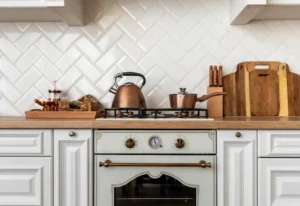
A good kitchen isn’t just about cabinets and countertops — it’s about rhythm. It’s where the day begins and where conversations stretch late into the night. The smell of coffee, the sound of a knife on a cutting board, the quiet hum of a fridge — it’s more than a room. It’s the home’s heartbeat.
That’s why kitchen design isn’t just an aesthetic choice. It’s emotional. It’s how you shape the space where life actually happens.
Where Style Meets Function
The best kitchens aren’t the biggest or the most expensive — they’re the ones that work.
Every movement feels natural: the sink near the stove, the prep area near the light, the fridge close enough but never in the way. Designers call it the “work triangle,” but it’s really about comfort and flow.
When you walk into a well-designed kitchen, you shouldn’t notice where everything is — you should just move.
Before picking materials or colors, think about how you live. Do you cook often? Entertain guests? Need space for kids to do homework? The design should fit you, not Pinterest.
The Power of Color
Color defines the mood of the kitchen.
White feels timeless — it reflects light, opens space, and pairs with anything. But too much white can feel sterile unless you warm it with wood, texture, or soft lighting.
Black or dark navy adds drama and modernity — bold but elegant when paired with brass or matte finishes. Natural greens and muted earth tones bring calmness and a sense of grounding, especially if your kitchen gets good sunlight.
And if you want to experiment? Do it with details — a painted island, patterned tile, or colorful chairs. Small touches change everything without locking you into one style.
Materials That Matter
Surfaces tell the story of how a kitchen lives.
Quartz and granite are durable and beautiful, but butcher block adds warmth and character. Marble looks luxurious but needs gentle care — perfect for people who see beauty in imperfection.
Cabinet finishes change the entire personality of the room. Matte paints feel soft and contemporary. Glossy ones bounce light and expand space. Wood grain — especially oak, walnut, or ash — brings natural depth that never goes out of style.
And don’t forget lighting. No material looks good under the wrong bulb. Layer your light — one for tasks, one for mood, one that flatters everything else.
Style That Tells a Story
Minimalist kitchens feel sleek and uncluttered, perfect for modern homes. But they work only if you love order. Every object must earn its place.
Farmhouse kitchens feel lived-in — warm colors, visible textures, open shelves. They’re about imperfection and comfort, not symmetry.
Scandinavian design blends both worlds — neutral tones, natural wood, soft light. It’s functional yet inviting. Industrial styles, with metal accents and exposed brick, bring a creative edge that suits lofts and city spaces.
The secret? Pick a style that feels like you. Not a magazine.
Little Details, Big Difference
Handles, faucets, and lighting are the jewelry of the kitchen. They might seem small, but they pull everything together.
Matte black or brushed brass adds a modern edge. Polished chrome feels classic. And open shelving, when done right, tells your story — favorite mugs, cookbooks, herbs. Real life mixed with design.
Plants also work wonders. Even a small potted basil or trailing ivy makes a kitchen feel alive.
Design for Real Life
The best kitchens age well because they’re designed for living, not just looking. Surfaces that forgive spills, drawers that close softly, and lighting that makes mornings easier — that’s real luxury.
And remember: you can always update. Paint cabinets, swap handles, change pendant lights — the structure stays, but the feeling evolves.
A beautiful kitchen isn’t perfect; it’s personal.
The Bottom Line
Designing a kitchen is about balance — color, function, emotion. It’s a room that should feel both inspiring and safe, clean but not cold, beautiful but usable.
Because the kitchen isn’t just where food is made. It’s where the house breathes — where life happens one meal, one laugh, one quiet morning at a time.
Picture Credit: Freepik
